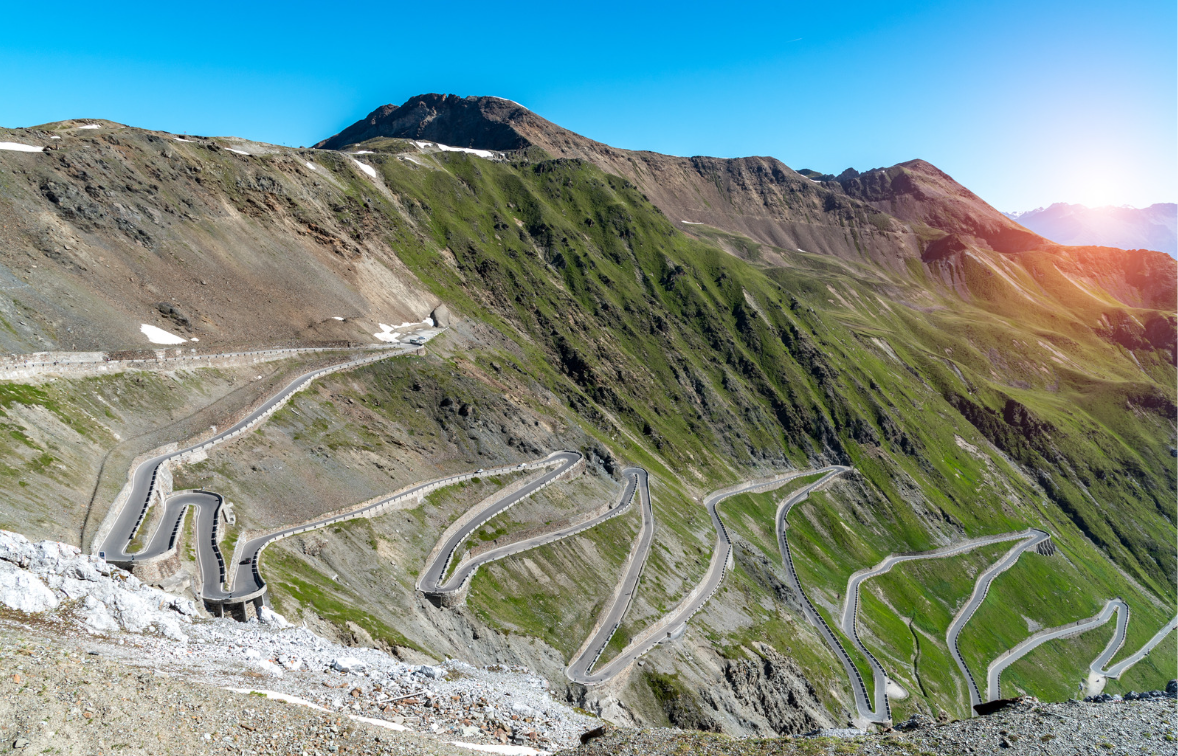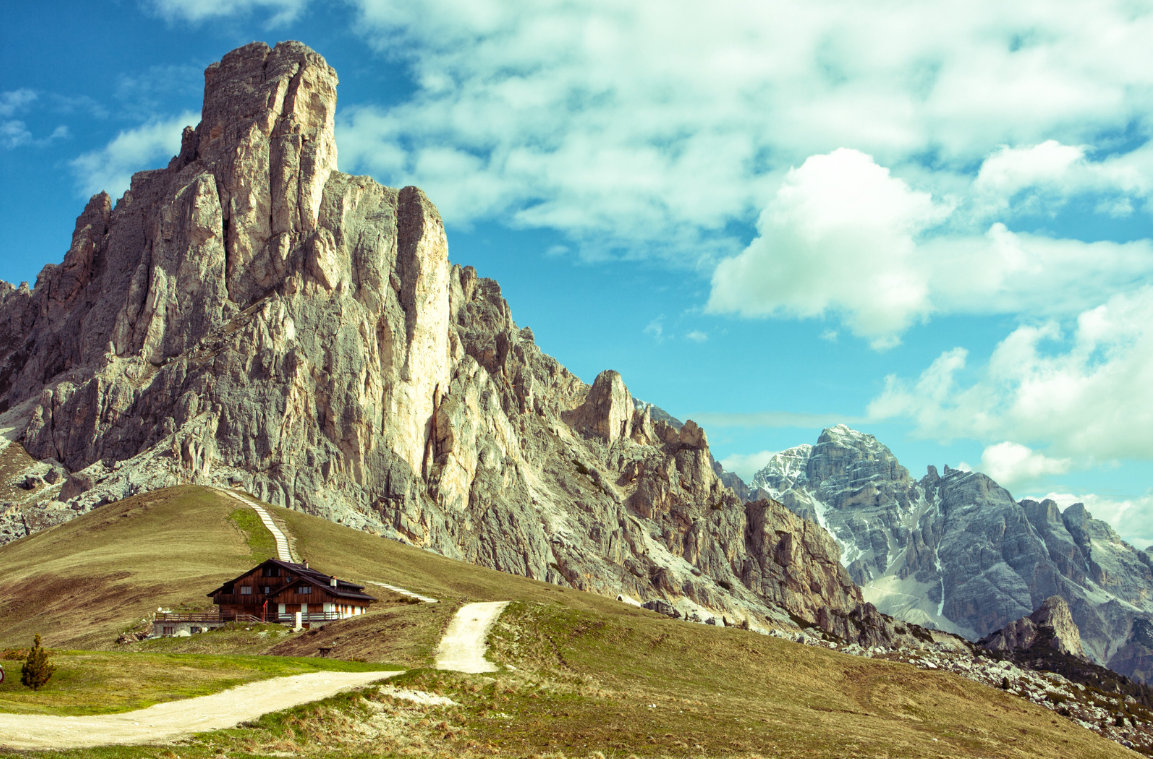Italy is a stunningly beautiful country with excellent food and a huge culture of road cycling. Steeped in cycling history, with many great Italian champions, it’s one of the best places on earth to ride a bicycle with the alps in the north culminating in the beautiful (and intimidatingly large) Mont Blanc, and the Apennine range running almost the entire length of the country.
The interesting geological history of Italy has led to a number of beautiful climbs, as watching any edition of the Giro d’Italia will show you. It’s a race still often won by pure climbers. Here, we’ve put together a list of seven Italian climbs. Some are in there for their beauty, others for their size and some for their cycling history. This list is by no means exhaustive either, with climbs such as the Mortirolo and Monte Zoncolan missing from our list.

Passo Stelvio
Length: 20.8km
Altitude Difference: 1,506m
Height: 2,724m
This is the second highest paved road in the alps, as a result it’s only open between May and September. This is a non-optional for any list of Italian climbs. It seems dreadfully uncreative to put the Passo Stelvio in first but this simple reality is that this is the most iconic climb in Italian cycling – possibly all cycling. There are two routes up the Passo Stelvio, Prato and Bormio. With both the KOM and QOM exceeding an hour the chances are you’ll want to train for this one…

Cipressa and Poggio
Length: 5.6km
Altitude Difference: 226m
Height: 231m
The world’s most boring bike race, until it isn’t, goes up here. These climbs are nothing in this list out of context but, when we consider the history of the Milano-Sanremo, it would seem odd not to include them. This is a race that has been going since 1907 and a quick glance at a map will tell you about its standout feature – Milan and Sanremo are a long way apart. The race usually exceeds 300km including the neutralised zone and the Cipressa and Poggio pair come at the end of this race. The best thing about not being a professional cyclist is that you can simply ride these climbs without the 250km preamble, just stay in Sanremo. Next year, the inaugural ‘Milano-Sanremo Donne’ is set to take place and it will be interesting to see if the predictable race dynamics of the men’s edition we’ve come to expect are mirrored in the women’s peloton.
Passo Giau
Length: 9.5km
Altitude Difference: 882m
Height: 2,203m
A real monster of the dolomites, the Passo Giau tops out over 2,200m (so probably best to leave it for summer). If you have ever taken part in the Maratona dles Dolomites then the Passo Giau is the 6th of 7 climbs on that route. The Giau is not particularly long but it has an average gradient of 9.3% making it absolutely relentless.

The Gavia
Length: 16.1km
Altitude Difference: 1,303m
Height: 2,599m
The Gavia is a beast, it tops out at over 2500m of altitude and will likely take you more than an hour to get up. With a moderate (for Italy) average gradient of 8.1% it’s not the hardest, or the longest, climb on this list but it has steep ramps of over 17% which, when half way up a long climb, will probably be somewhat uncomfortable. The altitude will be a factor on this one too – with it topping out over 2500m!
Madonna del Ghisallo
Length: 8.3km
Altitude Difference: 458m
Height: 751m
A staple of the race of the falling leaves – Il Lombardia. This climb sits on the edge of Lake Como and at the top is the Shrine to the Madonna del Ghisallo, and a museum about cycling. You can ride up this climb from three directions: Bellagio, Onno, or Canzo.
Muro di Sormano
Length: 1.6km
Altitude Difference: 268m
Height: 1,105m
A climb feared by professional cyclists, with an average gradient of around 17% the climb was actually removed from the Giro di Lombardia in 1962 because riders were either falling off or being pushed up by fans. Do you fancy having a go at a climb that was too steep for the pros of the 60s?
Siena – Strade Bianche final climb
Length: 0.6km
Altitude Difference: 58m
Height: 276m
The Tuscan city of Siena is beautiful even for Italian standards. The city was a centre of banking in the 13th and 14th centuries and is the home of the oldest bank in the world! With typically narrow streets and some steep hills the city also hosts the end of the Strade Bianche road race with gravel sectors. The climb is a short, punchy one up to the Piazza del Campo and has been the scene of some of the most memorable moments of modern cycling – in both the men’s and the women’s world tour peloton! It was the location of Mattieu Van Der Poel’s thermonuclear attack to drop Allaphilippe and Bernal to take Strade Bianche victory.
The rich history of Italian cycling combined with it’s uniquely active geographical history has created a country which is almost the perfect place to ride a bike. That, combined with the friendly people and the excellent coffee (which rarely costs more than €1.40) create a really great place to go if you’re into cycling. Whether you’re sprinting up the Cipressa, sending it down the Poggio descent or grinding up the Stelvio – you’re sure to have a beautiful time in Italy with your bicycle.










